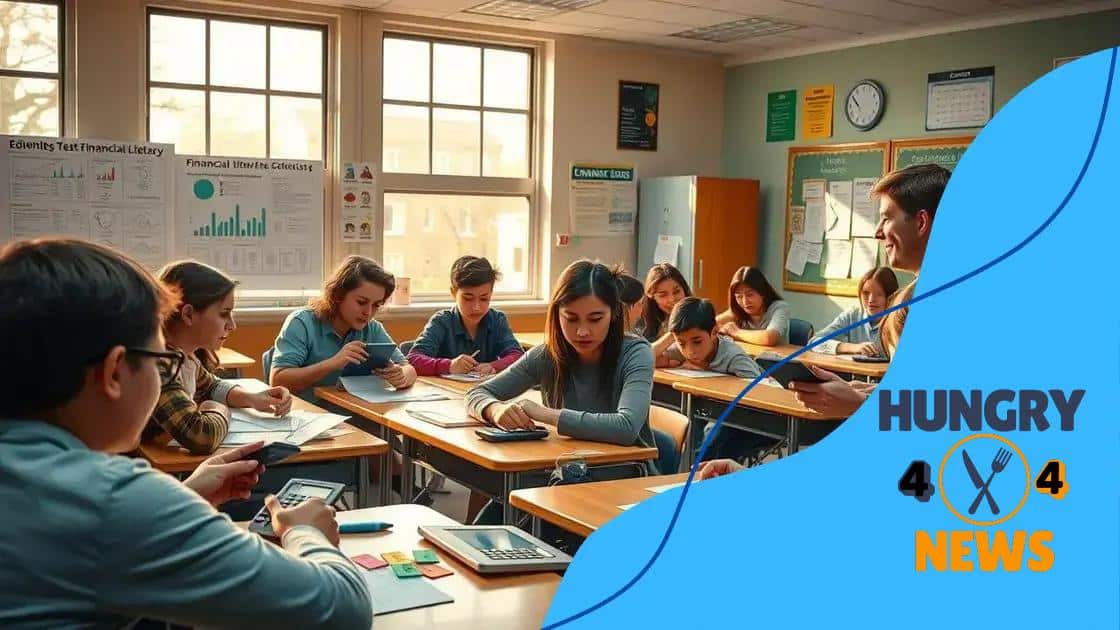Financial literacy programs for high school students: why they matter

Financial literacy programs for high school students provide essential skills in budgeting, saving, and investing, significantly enhancing their financial decision-making and long-term stability.
Financial literacy programs for high school students play a crucial role in equipping young people with the skills they need for a successful financial future. Have you ever wondered how understanding money management can impact their lives?
Understanding financial literacy and its importance
Understanding financial literacy is key for today’s youth. It prepares high school students to make informed decisions about money, savings, and investments. As they approach adulthood, having a solid grasp of financial principles plays a crucial role in their future success.
Many students enter college or the workforce without adequate knowledge of how to manage their finances. By introducing financial literacy programs early on, we can help students avoid common pitfalls. These programs cover essential topics such as budgeting, saving, and understanding credit.
Key Concepts of Financial Literacy
Firstly, budgeting is about managing income and expenses. It helps students track how much money they have and how to allocate it wisely. Secondly, savings teach the importance of setting aside money for future needs. Not all expenses are immediate, and saving for emergencies is crucial.
Additionally, knowing how credit works is vital. Students should learn how to build good credit and the consequences of poor credit decisions. Programs focusing on these concepts enable students to understand financial responsibilities.
Benefits of Learning Financial Literacy
- Improves decision-making regarding money.
- Encourages a habit of saving early.
- Reduces financial stress in adulthood.
- Teaches how to avoid debt traps.
Moreover, students who participate in financial literacy programs are likely to develop healthier financial habits. They become more confident in their money management abilities, which can lead to better financial outcomes in the long term. By understanding these fundamental concepts, students can take control of their financial futures, reducing the chances of falling into debt.
Overall, implementing financial literacy programs in high schools has a significant impact. These programs equip students with the knowledge to navigate a world brimming with financial challenges. As they learn and apply these skills, they become empowered to create a stable financial future.
Key components of effective financial literacy programs
Successful financial literacy programs must include various key components. These elements ensure students gain the knowledge they need to manage their money effectively.
Engaging Curriculum
An engaging curriculum is essential. It helps capture students’ attention and keeps them interested in the subject. Lessons should be interactive and relatable to real-life situations. By using practical examples, students can better understand the concepts.
Practical Skills Training
Another vital component is practical skills training. Students should learn how to create a budget, save effectively, and understand credit. These skills empower them to navigate everyday financial decisions. For instance, a hands-on approach like simulated budgeting exercises can make learning more impactful.
- Budgeting skills: Learning to track income and expenses.
- Savings techniques: Recognizing the importance of saving early.
- Understanding credit: Knowing how credit scores work and what affects them.
- Investing basics: Introduction to the idea of investing to grow wealth.
Moreover, effective programs should incorporate technology. Utilizing apps and online resources engages students in a manner they are familiar with. By integrating technology, such as financial planning tools, students can learn to manage finances more adeptly.
Real-World Applications
Real-world applications are also crucial. This means connecting lessons to students’ personal finances, such as understanding student loans, managing bank accounts, or discussing consumer rights. Bringing in guest speakers from local financial institutions can provide valuable insights.
Lastly, a strong support system enhances the learning experience. Mentors or instructors should be approachable and knowledgeable. Having a positive learning environment fosters open discussions about money and finance. This support encourages students to ask questions and build their confidence in managing finances.
How to implement financial literacy in high schools

Implementing financial literacy in high schools involves several key steps that ensure effective learning for students. To begin with, it’s important to assess the current curriculum. Schools should evaluate existing courses to identify where financial topics can be integrated.
Developing a Curriculum
A well-structured curriculum is essential. Schools can develop a financial literacy course that spans topics like budgeting, saving, and investing. It should be age-appropriate and aligned with national or state standards. Involving teachers in the development process ensures that the content is engaging and relevant.
Training Educators
Training educators is another crucial component. Teachers need the right tools and knowledge to effectively convey financial concepts. Workshops or professional development sessions can equip teachers with the skills they need. This enhances their confidence in teaching these topics and allows them to answer student questions more effectively.
- Provide training resources: Offer access to financial literacy materials.
- Encourage collaboration: Allow teachers to share best practices.
- Use expert speakers: Bring in financial professionals for guest lectures.
- Utilize online courses: Help educators learn at their own pace.
Moreover, engaging students through interactive methods is vital. Schools can incorporate simulations and hands-on activities. These activities help students grasp complex concepts like investments or credit scores. For instance, a budgeting project where students manage a mock bank account can provide practical experience.
Community Involvement
Involving the community can greatly enhance the program. Partnerships with local businesses or financial institutions can provide resources and real-world insights. Moreover, events like financial literacy fairs allow students to engage with financial experts, deepening their understanding.
Lastly, schools should evaluate and adapt the program over time. Gathering feedback from students and teachers is important for continuous improvement. Adjustments can be made based on what works best and what students find most interesting. This continuous improvement ensures that the program remains effective and engaging.
Benefits of financial education for students
The benefits of financial education for students are numerous and impactful. Understanding financial concepts from an early age equips them with essential skills for managing their money effectively.
Improved Money Management Skills
First, financial education helps students develop better money management skills. They learn how to budget, track their expenses, and save for the future. By understanding these principles, students become more responsible in handling their finances.
Greater Confidence in Financial Decisions
Moreover, financial education builds confidence. When students learn about concepts like credit scores and interest rates, they feel more prepared to make informed decisions. This increased confidence can lead to smarter choices when they encounter financial situations in real life.
- Informed financial decisions: Students learn to evaluate loan options and interest rates.
- Better saving habits: They understand the importance of saving early for future goals.
- Risk management: Students grasp how to manage risks, such as insurance.
- Investment knowledge: Facilitates understanding of basic investment strategies.
Additionally, financial education fosters critical thinking skills. Students must analyze their options, compare products, and anticipate future financial needs. This analytical mindset is valuable not only in financial matters but also in other areas of life.
Long-Term Financial Stability
Furthermore, the knowledge gained through financial education often translates into long-term financial stability. Students with a strong foundation are less likely to accumulate debt and more likely to invest wisely. This can lead to a more secure financial future as they transition into adulthood.
By instilling these skills and knowledge, schools can help break the cycle of financial illiteracy. When students understand how to manage their finances, they are more capable of achieving their personal and professional goals. This empowerment creates a positive ripple effect within families and communities.
Success stories from schools with financial literacy programs
Success stories from schools that have implemented financial literacy programs illustrate the positive impact on students and communities. These examples serve as inspiration for other schools looking to adopt similar programs.
Case Study: Greenfield High School
At Greenfield High School, financial literacy classes have transformed students’ understanding of personal finance. After introducing a comprehensive curriculum, students reported increased confidence in managing their money. They became more engaged with their finances and even started savings groups to encourage each other.
Case Study: River Valley Academy
River Valley Academy integrated financial education into its existing classes. This approach gave students practical lessons alongside their regular coursework. Students learned budgeting, saving, and investing through projects that required them to plan for real-life expenses, like planning a class trip.
- Increased participation: Students actively participated in class activities.
- Community engagement: Local businesses sponsored financial workshops.
- Improved outcomes: Test scores in personal finance increased dramatically.
These programs have fostered an environment where financial discussions are normalized. Students are eager to learn about credit cards, loans, and interest rates, topics that were previously daunting.
Effect on Student Futures
The long-term effects of these programs are also noteworthy. Graduates from these schools enter college or the workforce equipped with fundamental financial skills. Some even credit their success in managing student loans and expenses to the lessons learned during their high school years.
Additionally, parents have noticed a change in their children’s attitudes towards money. Students share their knowledge with family members, sparking discussions about budgeting and saving at home. This ripple effect enhances financial literacy within the entire community.
FAQ – Frequently Asked Questions about Financial Literacy Programs in High Schools
What are the key benefits of financial literacy programs for students?
Financial literacy programs equip students with essential money management skills, boost their confidence in making financial decisions, and promote long-term financial stability.
How can schools implement financial literacy education?
Schools can integrate financial literacy into existing curricula, develop dedicated classes, train educators, and involve community partners for real-world insights.
What topics are typically covered in financial literacy programs?
Topics commonly include budgeting, saving, investing, understanding credit, and managing expenses that empower students to make informed financial choices.
How do financial literacy programs impact students’ futures?
These programs significantly improve students’ ability to handle financial challenges, leading to smarter decisions about loans, savings, and investments in adulthood.





